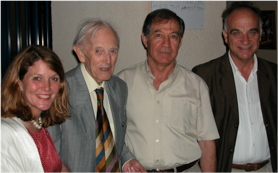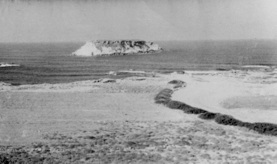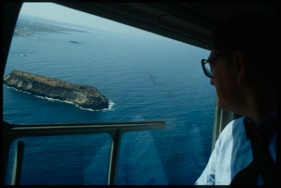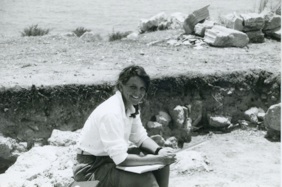History of Excavations
The place name Yeronisos, or “Holy Island,” is a very ancient one, known already in the first century B.C. to the Roman writer Pliny (Natural Histories 5.129-131) who speaks of an island called “Hiera” near Paphos in western Cyprus. A century later, Strabo (Geographies 14.6.4) mentions a place called “Hierocepis” nearby Paphos and Akamas. Steep cliffs, strong currents, and lack of water have long discouraged visitors from landing on Yeronisos. Its inaccessibility has allowed the island to remain one of the truly virgin sites of Cyprus, with ancient levels undisturbed since Byzantine times.
The American consul Luigi Palma di Cesnola, who cleared so many Cypriot sites of their antiquities during the 19th century, claimed to have visited the Roman tombs at Agios Georgios-tis-Peyias in 1876. Apparently, he was not tempted over to Yeronisos. D.G. Hogarth carefully explored the area in 1888 and later questioned whether Cesnola had ever actually visited Cape Drepanum, so different were his findings from those described by the American consul. Hogarth did not cross over to what he calls “St. George Island” but was informed by the Commissioner, Captain Thompson, that that the island contained cisterns, just like those found opposite on the mainland.
The first published account of a visit to Yeronisos is in Rupert Gunnis’s 1936 guidebook, Historic Cyprus: A guide to its towns and villages, monasteries and castles. Gunnis observed Neolithic flints and pottery along the southern edge of the island, the foundations of a Roman building (possibly a lighthouse, he says) at the most western point on the island, and the remains of defensive walls, a cistern, a millstone and other materials of the “Roman period.”
In December, 1981, The Ulysses Island Tourist Enterprises requested from the Cypriot Council of Ministers the lease of 26,000 sq. meters atop Yeronisos for development as a casino resort hotel, to be connected to the mainland by a causeway. As part of a feasibility study for this initiative, G. Petrides and M. Haralambous prepared a Geronisos Island Geotechnical Report, Ministry of Agriculture and Natural Resources, Geological Survey Department (Nicosia 1981).
In April 1982, a meeting of all interested parties with the ministerial committee failed to reach a consensus on the issue of leasing. Funding was allocated for trial excavations on Yeronisos under the direction of Dr. Sophocles Hadjisavvas of the Department of Antiquities of Cyprus. Twenty-three days of excavations were conducted on the island by Hadjisavvas’ team during the period October 11-November 19, 1982. Among the finds recovered were Chalcolithic stone tools, quantities of late Hellenistic imported fine wares, the only Ptolemaic ostraka found to date in all of Cyprus, a bronze blade, and Byzantine sgraffito ware bowl. Extensive architectural remains of cisterns, walls, kitchens, and other buildings were exposed. The island was expropriated by the Republic of Cyprus as a national heritage site of great cultural significance.
In Janury 1989, Joan Breton Connelly and Doris Miller of New York University visited Agios Georgios-tis-Peyias, followed by a trip atop Yeronisos in the summer of 1989 by Joan Connelly, Stuart and Laina Swiny, and Dimitris Michaelides in the boat of Mr. Andreas Stavrou of Peyia.
On June 15 1990, Order 223/1989 declared Yeronisos to be an ancient monument, adding it to the First Schedule of the Antiquities Law, as published in the Gazette.
Also in June, 1990, New York University was awarded a license to explore and excavate Yeronisos Island and its surrounding waters under the direction of Prof. Joan Breton Connelly. To date, one archaeological survey season (1990), two ecological survey seasons (1990, 1992), eleven excavation seasons (1992-1994, 1996-1997, 2004-2006, 2009-11) and seven study seasons (1995, 2000-2003, 2007-2008) have been completed.
In June of 1990, President John Brademas of New York University and his wife, Dr. Mary Ellen Brademas, visited Yeronisos and Agios Georgios-tis-Peyias by Cypriot Police Helicopter, inaugurating the opening of the University’s excavations at the site.
During the 1990 season, Peter P. Blanchard I11 of the Nature Conservancy of Mt. Desert Island, Maine and the Trust for Public Land, New York City undertook surveys of the Yeronisos flora and avian fauna. He collected, recorded and photographed plant samples and prepared an ecological map of Yeronisos. Geographical and general contour maps were obtained from the Geological Survey Department and the Department of Land Surveys which prepared a new aerial contour map of Yeronisos at 1:250, courtesy of Mr. Loucas Telemachou.
In 1992, the Cyprus Land Survey Office of Pafos renewed the benchmark on Yeronisos, setting a brass plate in a concrete column at the highest point on the island. This marks the precise elevation of 21.65m above sea level. The benchmark was determined off of a Level 6 Geodetic Survey point set on the mainland acropolis at Agios Georgios in 1923.
During the 1992 season, architect Andrew Wixom, aided by G.H.R. Wright, undertook a survey of the island with an electronic distance meter and prepared a new state plan of structures exposed prior to the start of the New York University Excavations. Wixom and Wright set three datum points (iron reinforcement rods in cement cased in PCV tubing) along a true North-South, East-West grid of 5 X 5 meter squares. This grid stretches over the entire site and extends across the channel to the mainland, allowing future underwater survey teams to utilize the same grid as the land operation.
During the 2000 season, a geophysical survey was conducted under the supervision of Mr. Glen Dash using a Geoscan Research FM 36 magnetic gradiometre. During the 2002 season a preliminary underwater survey was undertaken by Dr. Jonathan Cole of Oxford University’s Institute of Archaeology.
Excavations on the acropolis of Agios Georgios-tis-Peyias, just opposite Yeronisos, were undertaken by A. H. S. (Peter) Megaw during the years 1952–55. Prof. Charalambos Bakirtzis has continued work at the site since the 1990’s. Here, three early Byzantine basilicas of great import have been unearthed. They are especially well known for the impressive series of mosaics that show animals specific to the surrounding eco-system: several species of fish, cuttlefish, octopus, turtles, quails, and other birds. The basilicas were built during the reign of Justinian (AD 527–565) during a time when, according to Prof. Bakirtzis, Cape Drepanum served as an important stopover port for the grain ships carrying the annona civica from Egypt to Constantinople.











